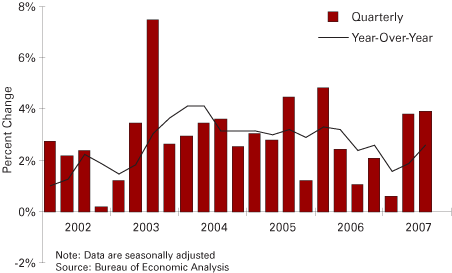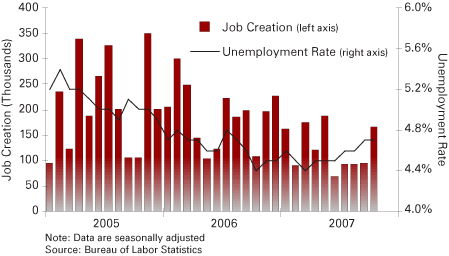The U.S. Economy
Associate Professor of Economics and Co-Director at the Center for Econometric Model Research, Indiana University Bloomington
During the past year, the U.S. economy has essentially been in survival mode. The good news as the year draws to a close is that we seem to have avoided intensive care. The not-so-good news is that the impediments to full recovery are not diminishing. Nevertheless, we expect the economy will avoid a crisis and continue to muddle through.
As shown in Figure 1, output growth in the United States decelerated for the fourth straight year during 2007. On a fourth-quarter to fourth-quarter basis, real gross domestic product (GDP) will probably grow by about 2.7 percent. By comparison, growth in 2003 reached 3.7 percent. The labor market shows a similar, but delayed, pattern (see Figure 2). During 2005, the economy was adding over 210,000 jobs each month. This slowed slightly to 190,000 per month in 2006, and has fallen to only 126,000 so far in 2007. Job growth for four of the past five months has been below 100,000. This latter level is insufficient to absorb new entrants into the labor market, causing the unemployment rate to rise from a low of 4.4 percent in March to 4.7 percent in October.
Figure 1
U.S. Real Output

Figure 2
U.S. Job Creation and Unemployment Rate

There are two basic pathogens causing this feeble performance. The more significant is the continuing collapse in the housing sector. Since peaking in late 2005, the decline has been dramatic. Housing starts, for example, have fallen by close to 50 percent. During the past summer, the situation seemed to be stabilizing, but turmoil in the mortgage market caused home sales to plummet during the fall. The weak sales environment has also become evident in housing prices, which are under pressure in most areas of the country.
The other source of negative pressure is the energy market. A year ago, oil prices were around $60 per barrel, and our expectation was that they would average about that level during 2007. Instead, there has been a steady increase, to above the $90 level as of late October.
In the face of these inflictions, it is a little surprising that the economy has held up as well as it has. The housing sector has cut overall growth by close to 1 percent. A rough rule of thumb has been that a $10 increase in the oil price will cut growth about 0.5 percent. Assuming that the economy has a sustainable growth of a little over 3 percent, it would have been easy for growth this year to have come in at a life support level around 1 percent. That the rate was more than 1 percent reflects several positive influences. First, the international trade picture improved. While this was partly due to a weak dollar, it is also driven by very good growth (the best ever, in fact) in the rest of the world. Second, business investment in structures and in high-tech equipment has been strong. Finally, consumption spending by households weakened, but did not collapse.
We expect a continuation of this basic pattern—solid trade numbers, adequate investment, and consumption at a level that is sufficient to maintain forward momentum in spite of continuing declines in the housing sector and pressure from energy prices. Some details:
- We expect output to grow about 2.5 percent in 2008. That will be slightly below 2007, and also below the long-run potential of the economy. Growth will be slower in the first half of the year, with some acceleration after mid-year.
- Employment will expand by about 1.1 million. Unemployment will rise early in the year, reaching perhaps 5 percent, and then will stabilize.
- Inflation will moderate from 2007, with assistance from relatively stable energy prices. The consumer price index will increase about 2.6 percent.
- The Federal Reserve, which lowered its target for the federal funds rate to 4.50 percent in September and October (from 5.25 percent), will cut the rate at least another 25 basis points.
This is a relatively optimistic scenario. It rests on some improvement from the 2007 experience in three areas.
- We expect oil prices to moderate from their recent peak. Although the average for the year will at least match 2007, the upward trend will end.
- The world economy will continue to be strong, allowing exports to be a solid support for the economy. Further depreciation of the dollar will contribute to this outcome.
- While housing will continue to weaken, the extent of its drag will lessen as the year proceeds. More importantly, troubles in this sector will not lead to a major retrenchment in consumption.
For each of these three, a less favorable scenario can by no means be ruled out. Energy prices have a substantial speculative element, and the political situation in the Middle East continues to exhibit significant instability. A crisis in that area could easily drive prices into totally uncharted territory. This would be bad for both the domestic economy and the world economy as a whole. The extremely strong growth in East Asia probably cannot continue indefinitely in any case. Finally, the very weak demand in the housing market could have more impact on housing prices than we foresee. If so, there could be a severe impact on consumer confidence.
We think that 2008 will be another year in successful survival mode. The crucial household sector will face pressures from several directions, but will not collapse. While there are definitely risks, there are enough positive signs to sustain moderate economic growth.
Also in this Issue…
- Outlook for 2008
- The International Economy
- The U.S. Economy
- Financial Forecast
- Housing
- Indiana Agriculture
- Indiana
- Anderson
- Bloomington
- Columbus
- Evansville
- Fort Wayne
- Gary
- Indianapolis-Carmel
- Kokomo
- Louisville
- Muncie
- Richmond
- South Bend-Mishawaka and Elkhart-Goshen
- Terre Haute
- Return to Table of Contents



